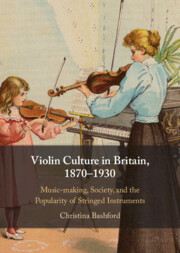 Violin Culture in Britain, 1870–1930
Violin Culture in Britain, 1870–1930 Book contents
- Violin Culture in Britain, 1870–1930
- Violin Culture in Britain, 1870–1930
- Copyright page
- Contents
- Figures
- Tables
- Acknowledgments
- Notes on the Text
- Abbreviations
- Introduction
- 1 Growth of a Culture
- Part I People and Practicalities
- 2 Starting Out
- 3 Moving Along
- 4 Advanced Training
- 5 Worlds of Work
- 6 Playing Together (1)
- 7 Playing Together (2)
- Part II The Conceptual Presence of Strings
- Conclusion
- Select Bibliography
- Index
3 - Moving Along
Learning and Attainment
from Part I - People and Practicalities
Published online by Cambridge University Press: 13 September 2025
- Violin Culture in Britain, 1870–1930
- Violin Culture in Britain, 1870–1930
- Copyright page
- Contents
- Figures
- Tables
- Acknowledgments
- Notes on the Text
- Abbreviations
- Introduction
- 1 Growth of a Culture
- Part I People and Practicalities
- 2 Starting Out
- 3 Moving Along
- 4 Advanced Training
- 5 Worlds of Work
- 6 Playing Together (1)
- 7 Playing Together (2)
- Part II The Conceptual Presence of Strings
- Conclusion
- Select Bibliography
- Index
Summary
Commercially run grade examinations and competitive music festivals, which tested learners’ attainment, were central to the consolidation of violin culture across Britain. Chapter 3 analyzes the string exams operated by three institutions, each of which targeted different socioeconomic groups. Bringing the College of Violinists – the first exam board to offer elementary string exams and the only one to guarantee string players would be assessed by specialists– into dialog with the more often discussed ABRSM and Society of Arts, the discussion evaluates exam requirements, candidate numbers, and success rates. At root, exams were tools for motivating students and supporting and shaping learning. Regional competition festivals offered additional opportunities for more advanced pupils’ performance to be assessed (in a public hall, as opposed to a private exam room) and, along with the exam boards, they contributed to the informal standardization of core repertoire. The chapter also surveys instructional materials, some of which were responses to the exam culture, and weighs students’ experiences of learning.
Keywords
Information
- Type
- Chapter
- Information
- Violin Culture in Britain, 1870–1930Music-making, Society, and the Popularity of Stringed Instruments, pp. 74 - 103Publisher: Cambridge University PressPrint publication year: 2025
Accessibility standard: WCAG 2.0 A
Why this information is here
This section outlines the accessibility features of this content - including support for screen readers, full keyboard navigation and high-contrast display options. This may not be relevant for you.Accessibility Information
Content Navigation
Allows you to navigate directly to chapters, sections, or non‐text items through a linked table of contents, reducing the need for extensive scrolling.
Provides an interactive index, letting you go straight to where a term or subject appears in the text without manual searching.
Reading Order & Textual Equivalents
You will encounter all content (including footnotes, captions, etc.) in a clear, sequential flow, making it easier to follow with assistive tools like screen readers.
You get concise descriptions (for images, charts, or media clips), ensuring you do not miss crucial information when visual or audio elements are not accessible.
Visual Accessibility
You will still understand key ideas or prompts without relying solely on colour, which is especially helpful if you have colour vision deficiencies.
Structural and Technical Features
You gain clarity from ARIA (Accessible Rich Internet Applications) roles and attributes, as they help assistive technologies interpret how each part of the content functions.